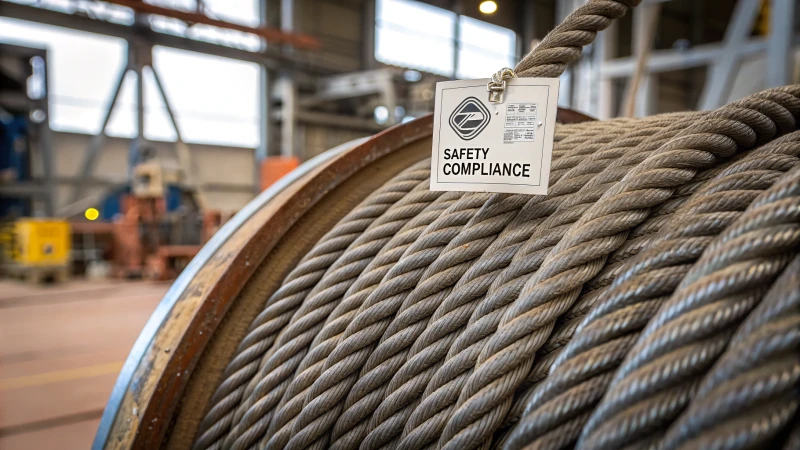
Have you ever wondered how to ensure the safety of steel wire ropes in heavy machinery operations?
To ensure safety in heavy machinery, steel wire ropes must adhere to ISO 2408 standards, which cover tensile strength, elongation, and fatigue resistance. Meeting these standards helps prevent equipment failure, enhancing workplace safety and minimizing risks.
Back when I first started managing procurement for our construction projects, I quickly learned the importance of these standards. A mentor once shared a story about a time he overlooked a minor compliance detail, which led to an equipment breakdown. It was a wake-up call for me. Understanding standards like ISO 2408 isn't just about ticking boxes—it's about ensuring everyone's safety on-site.
In addition to ISO 2408, there are other crucial protocols to consider. For instance, regular inspections and understanding the conditions for rope removal are vital in preventing accidents. Let's dive deeper into these practices to ensure that every piece of machinery operates smoothly and safely.
ISO 2408 is the only standard for steel wire ropes.False
ISO 2408 is important, but other standards also exist for safety.
Steel wire ropes must resist fatigue to ensure safety.True
Fatigue resistance is crucial to prevent rope failure under heavy loads.
How Do International Standards Like ISO 2408 Impact Steel Wire Rope Safety?
Imagine knowing that the steel wire ropes you depend on are held to the highest safety standards. That's what ISO 2408 offers.
ISO 2408 sets the benchmark for steel wire rope safety by detailing essential requirements for their construction, dimensions, and performance, ensuring they reliably support industrial tasks.
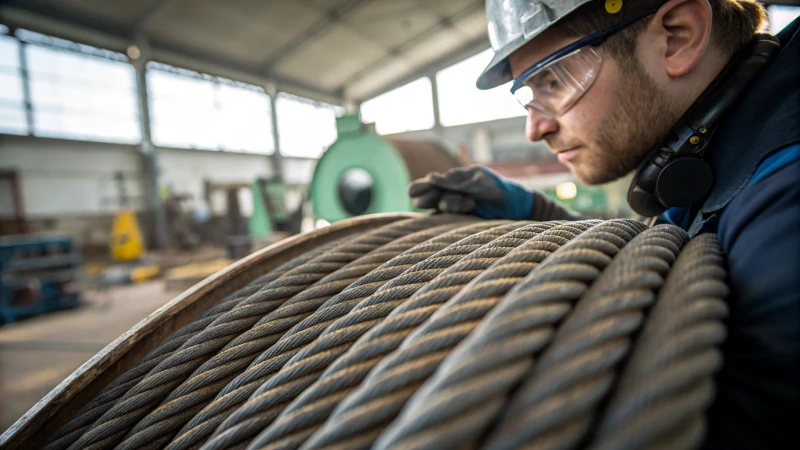
The Importance of ISO 2408 in Steel Wire Rope Safety
I remember the first time I had to source steel wire ropes for a major construction project. The stakes were high, and so was my stress level. It was crucial to find ropes that could handle not only the weight but also the unpredictable elements of the job site. That's when I realized how vital ISO 2408 is—it’s not just a standard; it's peace of mind.
ISO 2408 offers detailed guidelines covering everything from the construction1 of steel wire ropes to their testing and labeling. These standards are like a safety net, ensuring all ropes meet minimum safety requirements, dramatically reducing accident risks in industries that rely heavily on them.
Key Specifications of ISO 2408
- Dimensions: Specifies the diameter and tolerances.
- Construction: Details the core types and strand configurations.
- Performance Tests: Includes tensile strength and fatigue resistance tests.
| Parameter | Specification |
|---|---|
| Diameter | Tolerances up to ±5% |
| Tensile Strength | Minimum 1770 N/mm² |
| Core Type | Fiber or Steel Core |
Compliance and Its Impact on Safety
Adhering to ISO 2408 isn't just about ticking boxes—it's about ensuring every piece of equipment is fit for purpose. I’ve seen firsthand how non-compliance can lead to severe safety hazards2, like rope failures during critical operations. Sticking to these guidelines means not only safeguarding operations but also protecting our colleagues from potential harm.
Challenges in Implementing ISO 2408
Of course, compliance comes with its own set of challenges. Manufacturers have to invest in top-tier materials and processes to meet these standards. I recall a project where we had to opt for high-grade steel. It was a pricey decision, but looking back, the long-term benefits in safety and reliability far outweighed the initial costs.
Industry Impact and Future Outlook
With global regulations becoming ever stricter, there's a growing demand for ISO-compliant wire ropes. Industries like construction and mining are particularly keen on sourcing materials that adhere to these standards. This shift towards prioritizing safety3 and sustainability is more than just a trend—it's the future of industrial applications. And as someone who’s been in the thick of it, I can tell you it’s a change for the better.
ISO 2408 specifies tensile strength for steel ropes.True
ISO 2408 sets a minimum tensile strength of 1770 N/mm².
Non-compliance with ISO 2408 poses no safety risks.False
Non-compliance can lead to rope failure, posing safety hazards.
How Do I Inspect Steel Wire Ropes for Heavy Machinery?
Ever found yourself wondering if your steel wire ropes are up to the task? They’re the unsung heroes of heavy machinery, demanding regular check-ups to ensure they don’t give out when you need them most.
When inspecting steel wire ropes, it's crucial to look for signs of wear, corrosion, broken wires, and deformation. Following standards like ISO 2408 ensures these ropes are ready to handle the loads they face, keeping your machinery safe and operational.
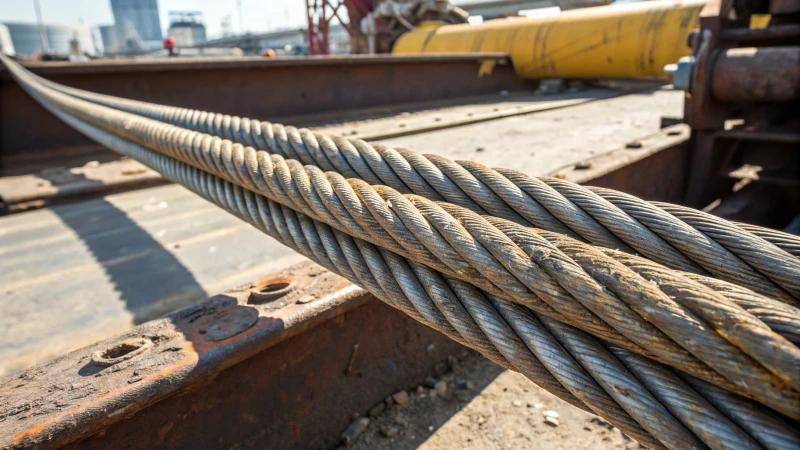
Visual and Physical Inspection
I remember the first time I had to inspect a steel wire rope; it was like trying to decipher a complex code. With experience, I learned that a keen eye for detail is key. Regular visual checks are essential—look for shiny wear spots, broken wires, or rust creeping in. Tools like calipers4 became my best friend, helping me gauge if there’s been a sneaky reduction in diameter.
Wear and Corrosion
Wear and corrosion are like silent saboteurs. I once overlooked a rusty patch, thinking it was minor, only to find it significantly weakened the rope. Now, I use a corrosion inhibitor5 religiously—it’s a small step that pays off big time. Trust me, replacing ropes before corrosion gets the upper hand is always the safer bet.
Broken Wires
Counting broken wires sounds tedious, but it’s crucial. I recall a mentor telling me about an incident where neglecting this led to a snapped rope—an experience I never want to replicate. So, as per ISO 2408, I make sure no more than 10% of wires are broken in any section.
| Criteria | Description |
|---|---|
| Broken Wires | Check for excessive broken wires in sections. |
| Diameter Reduction | Measure any reduction from original diameter. |
| Corrosion | Look for rust, pitting, or discoloration. |
| Deformation | Identify kinks, birdcaging, or other distortions. |
Deformation
Deformations can be tricky. I’ve seen ropes with birdcaging—where strands bulge out from the rope’s core—compromise entire operations. Regular checks and straightening techniques6 help keep things in line, literally.
Lubrication
Lubrication was a game-changer for me. It’s not just about reducing friction but also about protecting against corrosion. Applying the right lubricant7 during inspections can prolong the rope’s life significantly.
Understanding these inspection criteria has been pivotal for me. Sticking to a regular inspection schedule not only assures safety and compliance but also keeps machinery running smoothly—saving both time and money in the long run.
More than 10% broken wires require rope replacement.True
ISO 2408 standards recommend replacing ropes if over 10% of wires are broken.
Diameter reduction does not indicate wire rope wear.False
Diameter reduction is a key indicator of wear in steel wire ropes.
When is it time to replace steel wire ropes for safety?
I still remember the first time I stood at a construction site, marveling at the massive machinery and the steel wire ropes that supported them. It was clear that safety hinged on these cables.
Steel wire ropes should be replaced when you notice wear and tear, such as broken strands, corrosion, or deformations. Regular checks and following safety standards like ISO 2408 are vital.
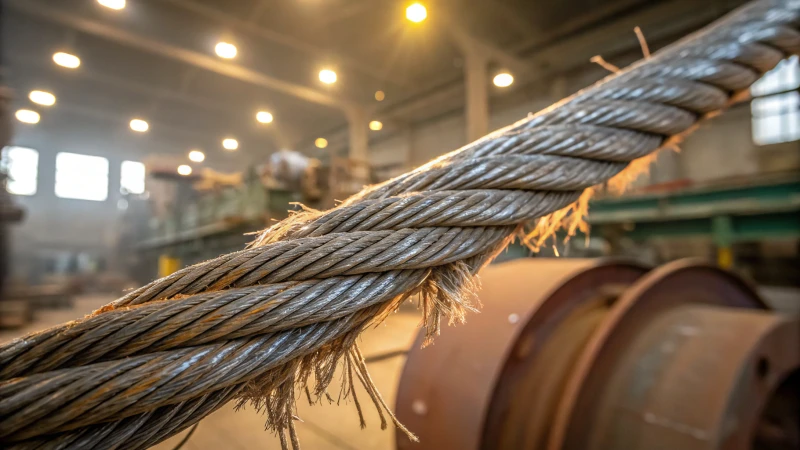
Spotting the Signs of Wear and Tear
When I first learned about steel wire ropes, I was amazed by how something so seemingly simple plays such a critical role in safety. Over time, through various projects, I’ve come to understand that regular inspections are not just a box-ticking exercise—they're crucial. If you ever notice broken wires or fatigue cracks8, it’s time to act. Corrosion is another red flag, especially if your operations are near salty environments, which accelerates damage.
| Inspection Criteria | Frequency | Recommended Action |
|---|---|---|
| Broken Strands | Monthly | Replace if more than 10% are broken |
| Corrosion | Quarterly | Replace if rust is extensive |
| Deformation | Monthly | Immediate replacement |
Sticking to Safety Standards
Adhering to international standards like ISO 2408 has been a guiding principle in my procurement decisions. These standards aren’t just bureaucratic hurdles; they provide a framework that ensures the ropes can handle the heavy loads they’re subjected to without compromising safety. Ignoring these standards could lead to disastrous consequences and, let’s be honest, none of us want to deal with the potential legal fallout9.
Quality Matters
I've always believed that investing in high-quality materials pays off in the long run. It’s like choosing the right partner for a dance; everything falls into place when it's a good match. Superior materials can extend the lifespan of steel wire ropes, meaning fewer replacements and less downtime. This is crucial when aligning with stringent global regulations.
Environmental Challenges
Having worked on projects near the coast, I've seen firsthand how environmental factors can accelerate wear. Saltwater is particularly notorious for causing corrosion. In such settings, opting for stainless steel or galvanized options can make all the difference, reducing the need for frequent replacements and keeping everything running smoothly.
More than 10% broken strands require rope replacement.True
ISO standards recommend replacing ropes if over 10% of strands are broken.
Stainless steel ropes need more frequent replacements.False
Stainless steel ropes resist corrosion better, requiring less frequent replacements.
How Do OSHA Regulations Affect Steel Wire Rope Usage?
Diving into OSHA regulations might sound dry, but when it comes to steel wire ropes, it's a safety net you can't ignore.
OSHA regulations impact steel wire rope usage by setting safety standards and inspection requirements, ensuring ropes are maintained and replaced as needed to protect workers.
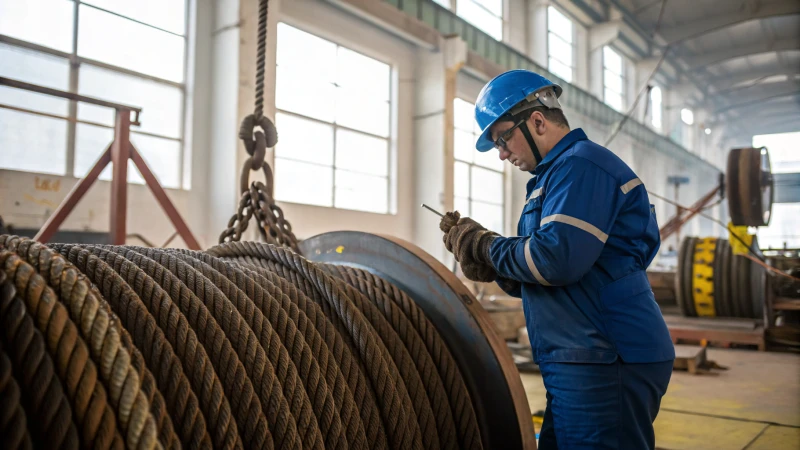
Overview of OSHA Regulations
When I first started navigating the world of steel wire ropes, OSHA's guidelines felt like a beacon in the fog. They provide clear instructions on how to safely use these ropes across various industries, and honestly, knowing these regulations gave me peace of mind. The rules cover everything from inspection processes10 to the maintenance and replacement of ropes, all to minimize workplace hazards.
Key OSHA Requirements
These regulations felt daunting at first, but breaking them down helped. Here are some of the key requirements:
- Inspection Frequency: I learned that daily visual checks before each shift were non-negotiable, along with monthly detailed inspections by qualified personnel. This routine was like brushing my teeth—essential for keeping problems at bay.
- Load Limits: It was tempting to push limits, but sticking to the manufacturer’s specified load limits became a rule I lived by. I realized overloading was a recipe for disaster, not just for the ropes but for everyone on site.
- Removal Criteria: If ever I noticed excessive wear or broken wires, I knew it was time to retire those ropes. This wasn't just about following rules—it was about ensuring everyone made it home safely.
| OSHA Requirement | Description |
|---|---|
| Inspection Frequency | Daily visual checks and monthly detailed inspections |
| Load Limits | Must not exceed manufacturer-specified load limits |
| Removal Criteria | Remove if excessive wear, broken wires, or corrosion are present |
Impacts on Procurement and Maintenance
For procurement managers like John or Emma, understanding these regulations is more than just a checkbox; it's about choosing suppliers who prioritize safety as much as they do. I've seen firsthand how suppliers adhering to OSHA guidelines offer ropes that can handle heavy loads without compromising safety. Investing in quality ropes might seem costly upfront, but it pays off in long-term safety and efficiency.
Global Compliance Considerations
Even if OSHA regulations are primarily U.S.-focused, their principles echo in international standards. For those working outside the U.S., like Klaus or Sarah, local regulations often mirror these concerns. It's reassuring to know that by aligning with global standards11, companies can uphold high safety and operational standards worldwide. This global perspective ensures that no matter where projects take place, safety remains the top priority.
OSHA requires daily steel wire rope inspections.True
OSHA mandates daily visual checks before each shift for safety.
OSHA allows steel ropes to exceed load limits.False
Exceeding manufacturer-specified load limits is prohibited by OSHA.
Conclusion
Steel wire ropes in heavy machinery must meet ISO 2408 standards for safety, including tensile strength and fatigue resistance, ensuring reliable performance and minimizing workplace risks.
-
Explore detailed construction specifications outlined by ISO 2408 to understand how they enhance safety in various applications. ↩
-
Learn about potential safety risks associated with non-compliance to emphasize the importance of adhering to ISO 2408 standards. ↩
-
Discover how evolving industry standards and regulations are shaping the future of steel wire rope safety. ↩
-
Discover tools to enhance inspection accuracy, ensuring early detection of wear and damage. ↩
-
Learn about top corrosion inhibitors to extend the lifespan of steel wire ropes. ↩
-
Explore methods to correct minor deformations in steel wire ropes. ↩
-
Find suitable lubricants to reduce friction and prevent corrosion in steel ropes. ↩
-
Understanding common deformations helps identify when a rope is compromised, ensuring timely replacement and continued safety. ↩
-
Non-compliance with ISO 2408 can result in severe legal consequences, making it crucial to understand the risks involved. ↩
-
Learn about OSHA's specific inspection criteria to ensure safety and compliance. ↩
-
Explore global standards that align with OSHA to ensure international compliance. ↩

